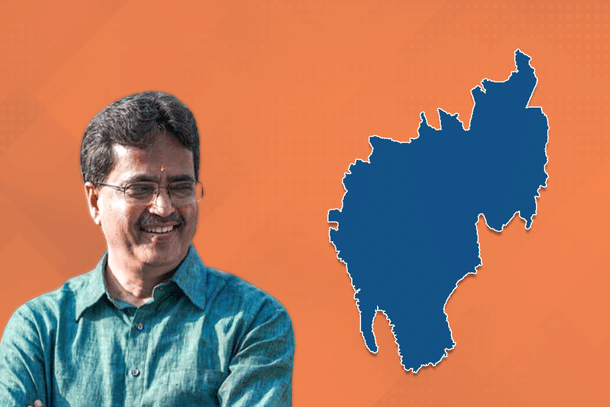Politics
Tripura Is Finally Getting Its Act Together, But Will The 'Double Engine' Continue?
Venu Gopal Narayanan
Jan 27, 2023, 11:09 AM | Updated 07:14 PM IST
Save & read from anywhere!
Bookmark stories for easy access on any device or the Swarajya app.


In 2018, the Bharatiya Janata Party (BJP) emerged like a proverbial bolt from the blue, to win the assembly elections in Tripura. This brought an end to a record twenty-year continued tenure of then chief minister Manik Sarkar of the Communist Party of India (Marxist), the CPI(M).
It also ended an unbroken, quarter-century long domination of Tripura politics by the Communists. And the Congress, the principal opposition party, ceased to exist.
The BJP soared from nil seats and just over one per cent of the vote share in 2013, to 36 seats and 44 per cent in a house of 60. Together with its ally, the Indigenous People's Front of Tripura (IPFT), the coalition won 44 seats with 51 per cent of the vote.

The Congress slumped from 37 per cent to under two per cent, with almost all of its vote base shifting en masse to the BJP. The Communists, too, suffered a stiff decline. They fell to their lowest seat tally in half a century, with the only saving grace that they were at least able to retain the bulk of their vote base.
Of the 60 seats in the legislature, 20 are reserved for tribals and 10 for Dalits. The BJP and the IPFT won 18 (nine each) of the 20 tribal seats, and the BJP won 8 of the 10 seats reserved for scheduled castes.
The true scale of the 2018 victory becomes apparent when we see that the BJP-IPFT alliance got more than 50 per cent of the vote in 33 of the 44 seats they won.
This dramatic – indeed, paradigmatic shift – is more evident in the maps below.

But it has not been an easy five years for the BJP, as they seek to gain a renewed mandate in Tripura next month. Their first chief minister, Biplab Kumar Deb, had to make way for Manik Saha in May 2022.
Their only ally in the state, the IPFT, a local tribal party, has quit a very profitable electoral alliance. Former Congress dynast-stalwart Sudip Roy Barman, who joined the BJP in 2018, resigned early last year, re-joined the Congress, and won his bypoll.
Tipraha Indigenous Progressive Regional Alliance (TIPRA), a new political outfit led by a Tripura royal has risen strongly in the tribal areas. And the Congress and the Communist parties have announced that they will formally contest the forthcoming elections together.
What Does This Mean?
Under the Congress initially, and then for a longer period under the Communists, Tripura was treated as a cauldron of identities for varying reasons of electoralbenefit.
The problem began with an influx of Bengali-speaking refugees after the 1971 war, which drove the tribals into the hills and reduced them to a minority.
Into this mix arrived Christian evangelists and Muslim illegal immigrants. That finally led in the late 1980s to the rise of a violent insurgency based in Bangladesh, along with multiple reports of forced conversions to Christianity in tribal areas.
This was unfortunate, avoidable, and unforgivable, because Tripura is actually blessed with abundant natural resources. It produces substantial volumes of natural gas, and has rich agro-industrial potential.
Yet, the ugly situation festered for decades until the general elections of 2014 triggered an unprecedented political upheaval in Tripura four years later.
In the past five years, the BJP-led government has clamped down on insurgents, while focusing on investments and development. A number of administrative delays in the Oil and Natural Gas Corporation’s (ONGC) hunt for more gas, which had lingered in wretched limbo for a decade, were finally resolved in 2017.
As a result, ONGC has already announced new discoveries, and is gearing up to try and explore for oil in deeper prospects. Tripura now exports electricity to Bangladesh.
Regional connectivity has increased vastly and is set to improve further, with a slew of highways, rail overbridges, and concrete roads on the anvil.
Simultaneously, investment is being sought through attractive schemes by the state’s new industrial policy, and facilitated by its industrial development corporation. Its focus includes rubber, bamboo, Agar Oil, tea, and tourism infrastructure.
Gas-based power generation is being ramped up, as is transmission and distribution infrastructure. There is a formal plan to ensure uninterrupted power supply to the entire state, which includes laying underground cables, smart metering, and the setting up of a floating power plant at Dumbar lake in the tribal tracts.
And yet, sadly, for all that, the forthcoming elections will once again degenerate into a messy squabble by the opposition as they commence a hunt for identity vote, in their desperate attempts to somehow dislodge the BJP from the treasury benches.
How that may play out, what the electoral battlespace looks like, and how various parties and coalitions might fare, will be covered in a companion piece, along with the detailed election math.
Venu Gopal Narayanan is an independent upstream petroleum consultant who focuses on energy, geopolitics, current affairs and electoral arithmetic. He tweets at @ideorogue.





